Project Management: Methods, Theories, Planning and Risk Analysis
VerifiedAdded on 2023/01/05
|16
|5213
|85
Report
AI Summary
This project management report provides a comprehensive overview of project management principles, methods, and theories. It begins with definitions and a critical evaluation of various project management methods, including Agile, Scrum, Kanban, Lean, and Waterfall, along with their suitability for different project types. The report then delves into project management theories, such as the change view and the management-as-planning, dispatching, and regulator models. It assesses the value of project planning methods, individual plans, and project management processes for diverse organizations and business objectives, emphasizing the importance of disciplined project management at the portfolio level. Finally, it addresses risk management in projects, highlighting the process of identifying, analyzing, and responding to potential risks to ensure project success. The report underscores the significance of project management for achieving organizational goals and mitigating potential challenges.
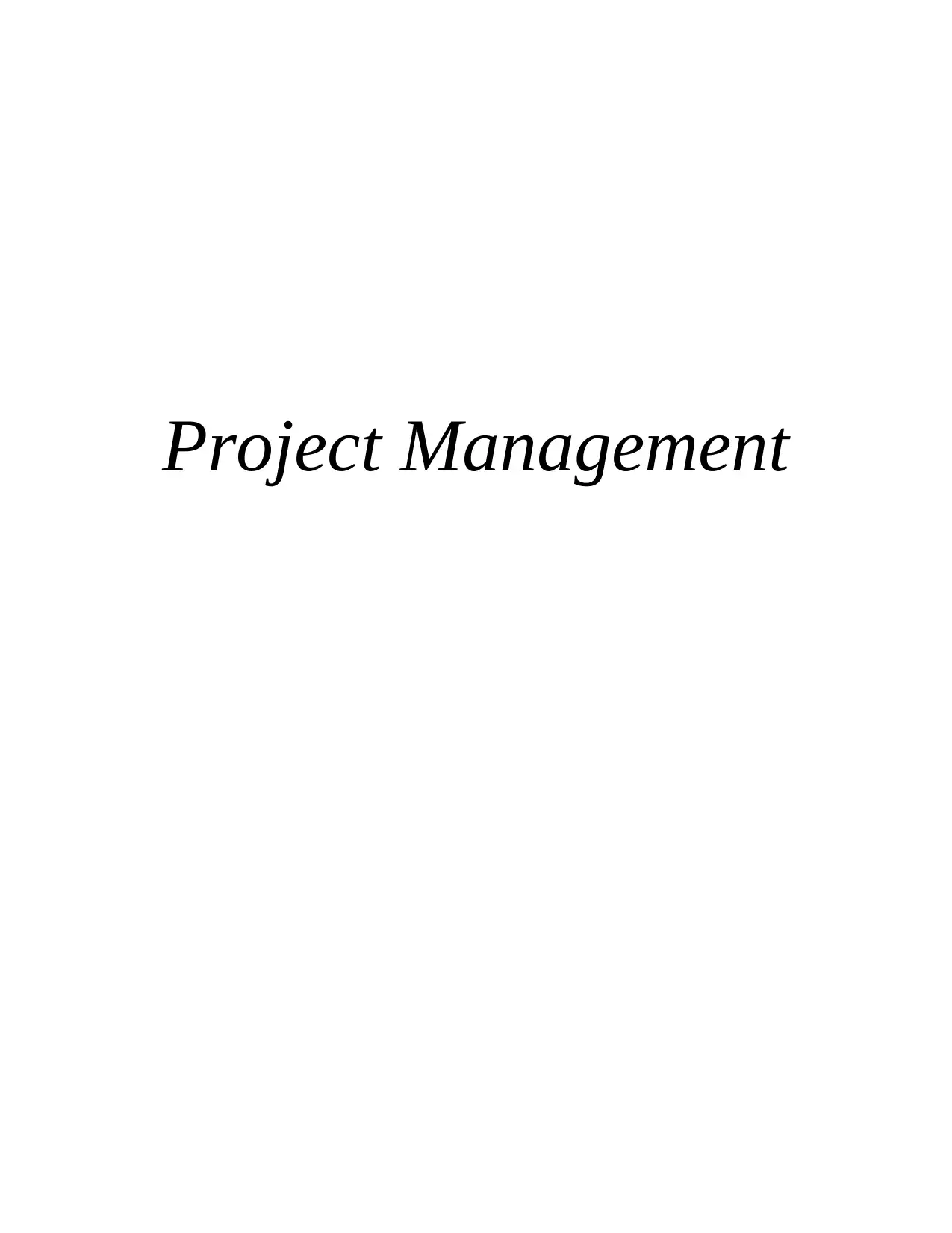
Project Management
Paraphrase This Document
Need a fresh take? Get an instant paraphrase of this document with our AI Paraphraser
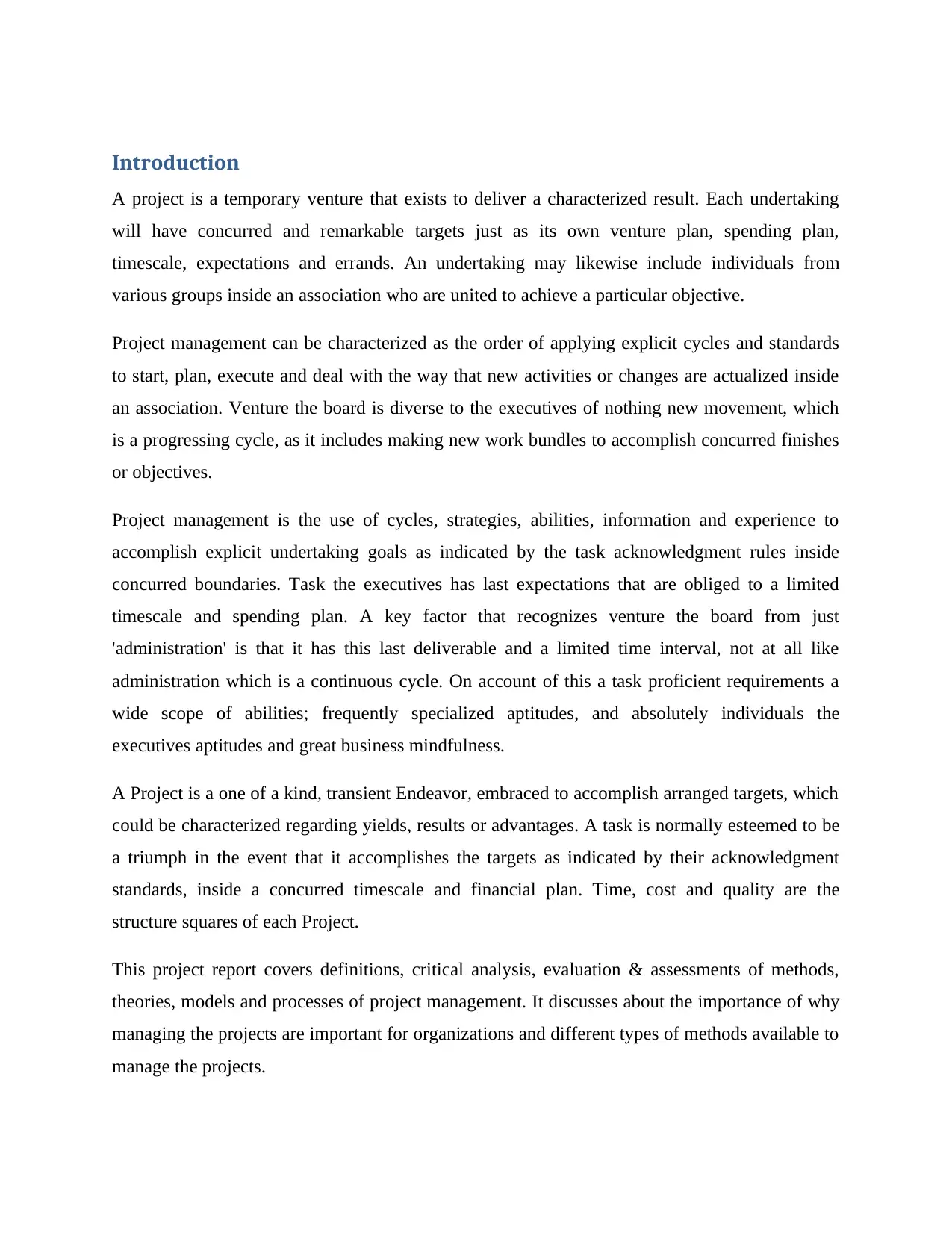
Introduction
A project is a temporary venture that exists to deliver a characterized result. Each undertaking
will have concurred and remarkable targets just as its own venture plan, spending plan,
timescale, expectations and errands. An undertaking may likewise include individuals from
various groups inside an association who are united to achieve a particular objective.
Project management can be characterized as the order of applying explicit cycles and standards
to start, plan, execute and deal with the way that new activities or changes are actualized inside
an association. Venture the board is diverse to the executives of nothing new movement, which
is a progressing cycle, as it includes making new work bundles to accomplish concurred finishes
or objectives.
Project management is the use of cycles, strategies, abilities, information and experience to
accomplish explicit undertaking goals as indicated by the task acknowledgment rules inside
concurred boundaries. Task the executives has last expectations that are obliged to a limited
timescale and spending plan. A key factor that recognizes venture the board from just
'administration' is that it has this last deliverable and a limited time interval, not at all like
administration which is a continuous cycle. On account of this a task proficient requirements a
wide scope of abilities; frequently specialized aptitudes, and absolutely individuals the
executives aptitudes and great business mindfulness.
A Project is a one of a kind, transient Endeavor, embraced to accomplish arranged targets, which
could be characterized regarding yields, results or advantages. A task is normally esteemed to be
a triumph in the event that it accomplishes the targets as indicated by their acknowledgment
standards, inside a concurred timescale and financial plan. Time, cost and quality are the
structure squares of each Project.
This project report covers definitions, critical analysis, evaluation & assessments of methods,
theories, models and processes of project management. It discusses about the importance of why
managing the projects are important for organizations and different types of methods available to
manage the projects.
A project is a temporary venture that exists to deliver a characterized result. Each undertaking
will have concurred and remarkable targets just as its own venture plan, spending plan,
timescale, expectations and errands. An undertaking may likewise include individuals from
various groups inside an association who are united to achieve a particular objective.
Project management can be characterized as the order of applying explicit cycles and standards
to start, plan, execute and deal with the way that new activities or changes are actualized inside
an association. Venture the board is diverse to the executives of nothing new movement, which
is a progressing cycle, as it includes making new work bundles to accomplish concurred finishes
or objectives.
Project management is the use of cycles, strategies, abilities, information and experience to
accomplish explicit undertaking goals as indicated by the task acknowledgment rules inside
concurred boundaries. Task the executives has last expectations that are obliged to a limited
timescale and spending plan. A key factor that recognizes venture the board from just
'administration' is that it has this last deliverable and a limited time interval, not at all like
administration which is a continuous cycle. On account of this a task proficient requirements a
wide scope of abilities; frequently specialized aptitudes, and absolutely individuals the
executives aptitudes and great business mindfulness.
A Project is a one of a kind, transient Endeavor, embraced to accomplish arranged targets, which
could be characterized regarding yields, results or advantages. A task is normally esteemed to be
a triumph in the event that it accomplishes the targets as indicated by their acknowledgment
standards, inside a concurred timescale and financial plan. Time, cost and quality are the
structure squares of each Project.
This project report covers definitions, critical analysis, evaluation & assessments of methods,
theories, models and processes of project management. It discusses about the importance of why
managing the projects are important for organizations and different types of methods available to
manage the projects.
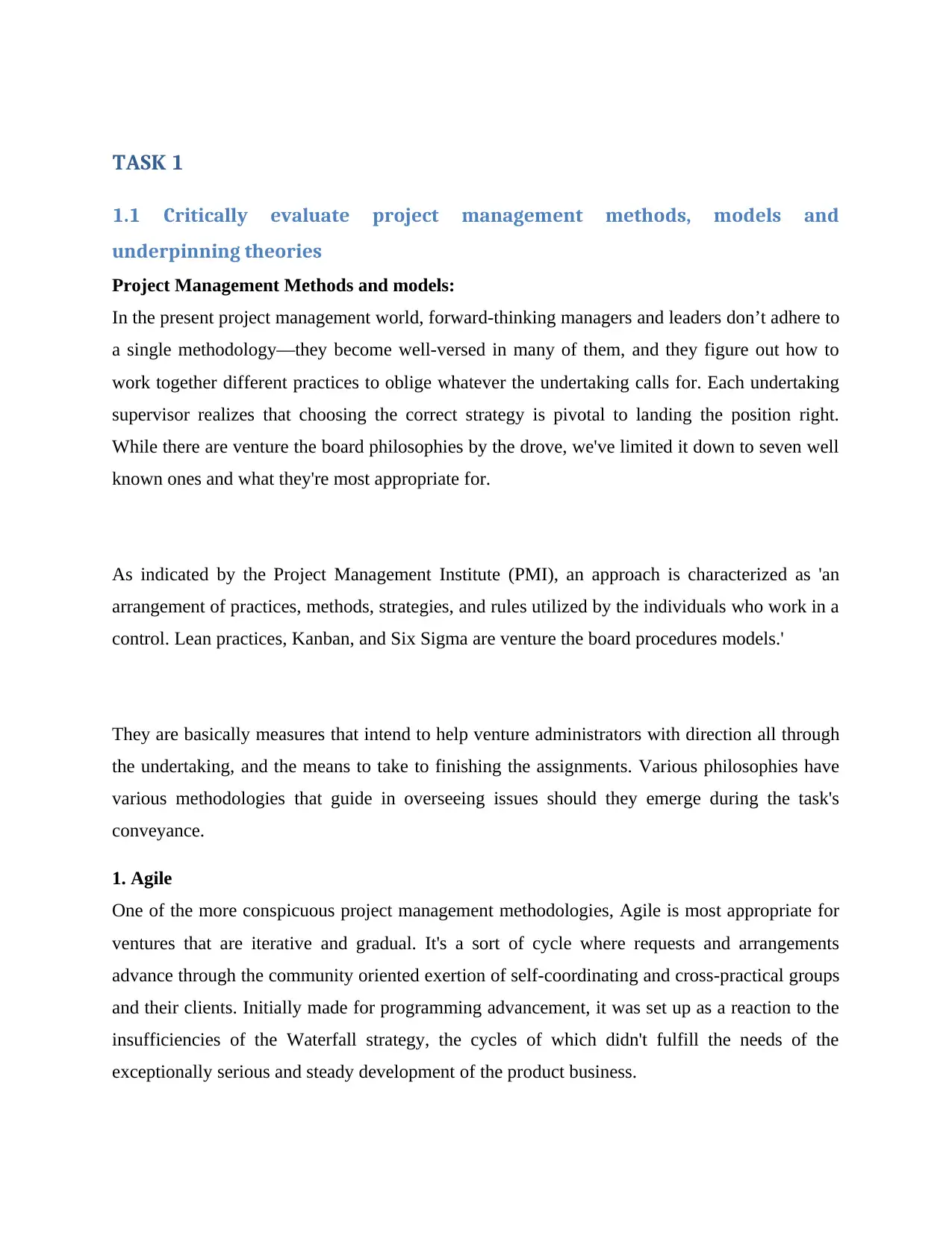
TASK 1
1.1 Critically evaluate project management methods, models and
underpinning theories
Project Management Methods and models:
In the present project management world, forward-thinking managers and leaders don’t adhere to
a single methodology—they become well-versed in many of them, and they figure out how to
work together different practices to oblige whatever the undertaking calls for. Each undertaking
supervisor realizes that choosing the correct strategy is pivotal to landing the position right.
While there are venture the board philosophies by the drove, we've limited it down to seven well
known ones and what they're most appropriate for.
As indicated by the Project Management Institute (PMI), an approach is characterized as 'an
arrangement of practices, methods, strategies, and rules utilized by the individuals who work in a
control. Lean practices, Kanban, and Six Sigma are venture the board procedures models.'
They are basically measures that intend to help venture administrators with direction all through
the undertaking, and the means to take to finishing the assignments. Various philosophies have
various methodologies that guide in overseeing issues should they emerge during the task's
conveyance.
1. Agile
One of the more conspicuous project management methodologies, Agile is most appropriate for
ventures that are iterative and gradual. It's a sort of cycle where requests and arrangements
advance through the community oriented exertion of self-coordinating and cross-practical groups
and their clients. Initially made for programming advancement, it was set up as a reaction to the
insufficiencies of the Waterfall strategy, the cycles of which didn't fulfill the needs of the
exceptionally serious and steady development of the product business.
1.1 Critically evaluate project management methods, models and
underpinning theories
Project Management Methods and models:
In the present project management world, forward-thinking managers and leaders don’t adhere to
a single methodology—they become well-versed in many of them, and they figure out how to
work together different practices to oblige whatever the undertaking calls for. Each undertaking
supervisor realizes that choosing the correct strategy is pivotal to landing the position right.
While there are venture the board philosophies by the drove, we've limited it down to seven well
known ones and what they're most appropriate for.
As indicated by the Project Management Institute (PMI), an approach is characterized as 'an
arrangement of practices, methods, strategies, and rules utilized by the individuals who work in a
control. Lean practices, Kanban, and Six Sigma are venture the board procedures models.'
They are basically measures that intend to help venture administrators with direction all through
the undertaking, and the means to take to finishing the assignments. Various philosophies have
various methodologies that guide in overseeing issues should they emerge during the task's
conveyance.
1. Agile
One of the more conspicuous project management methodologies, Agile is most appropriate for
ventures that are iterative and gradual. It's a sort of cycle where requests and arrangements
advance through the community oriented exertion of self-coordinating and cross-practical groups
and their clients. Initially made for programming advancement, it was set up as a reaction to the
insufficiencies of the Waterfall strategy, the cycles of which didn't fulfill the needs of the
exceptionally serious and steady development of the product business.
⊘ This is a preview!⊘
Do you want full access?
Subscribe today to unlock all pages.

Trusted by 1+ million students worldwide
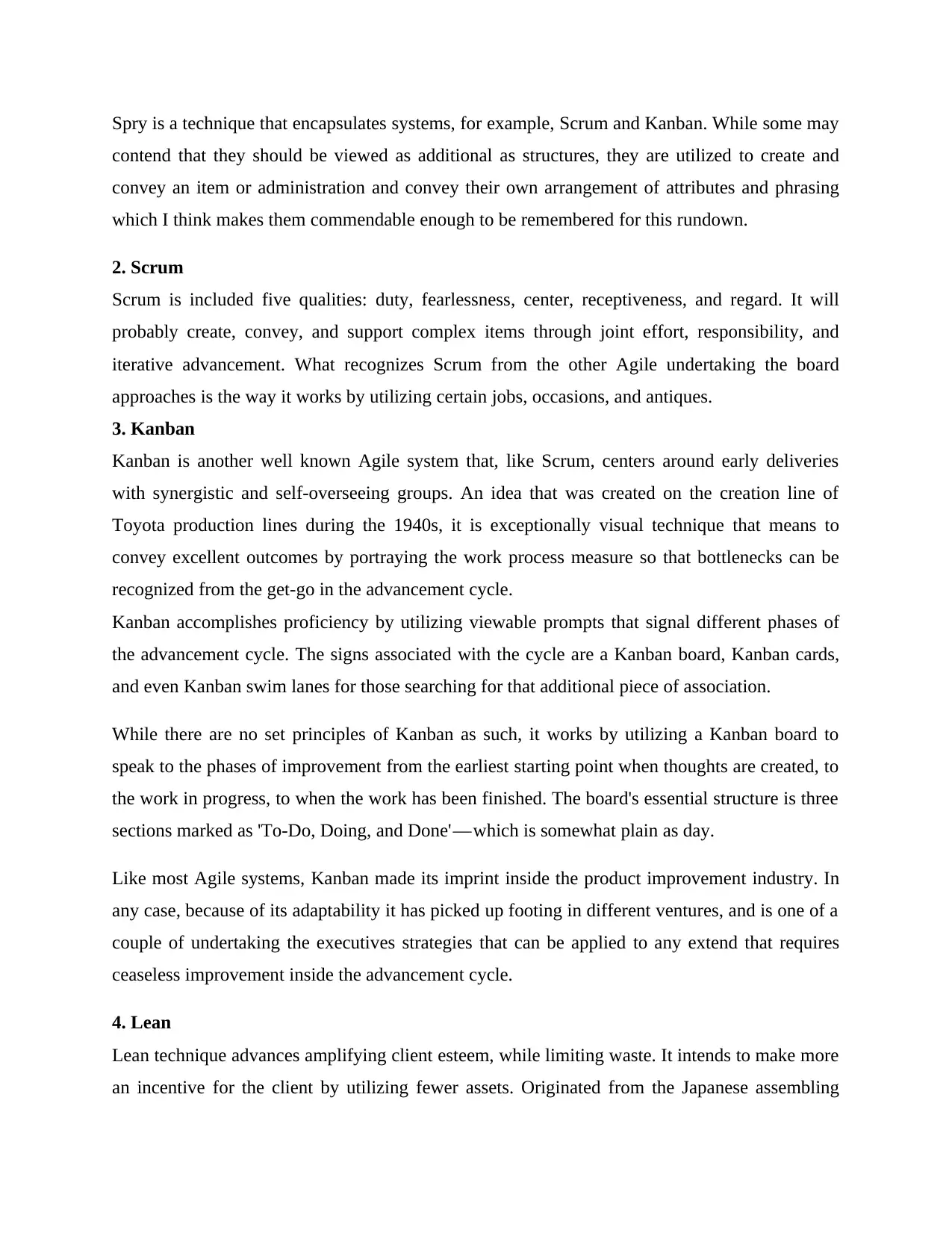
Spry is a technique that encapsulates systems, for example, Scrum and Kanban. While some may
contend that they should be viewed as additional as structures, they are utilized to create and
convey an item or administration and convey their own arrangement of attributes and phrasing
which I think makes them commendable enough to be remembered for this rundown.
2. Scrum
Scrum is included five qualities: duty, fearlessness, center, receptiveness, and regard. It will
probably create, convey, and support complex items through joint effort, responsibility, and
iterative advancement. What recognizes Scrum from the other Agile undertaking the board
approaches is the way it works by utilizing certain jobs, occasions, and antiques.
3. Kanban
Kanban is another well known Agile system that, like Scrum, centers around early deliveries
with synergistic and self-overseeing groups. An idea that was created on the creation line of
Toyota production lines during the 1940s, it is exceptionally visual technique that means to
convey excellent outcomes by portraying the work process measure so that bottlenecks can be
recognized from the get-go in the advancement cycle.
Kanban accomplishes proficiency by utilizing viewable prompts that signal different phases of
the advancement cycle. The signs associated with the cycle are a Kanban board, Kanban cards,
and even Kanban swim lanes for those searching for that additional piece of association.
While there are no set principles of Kanban as such, it works by utilizing a Kanban board to
speak to the phases of improvement from the earliest starting point when thoughts are created, to
the work in progress, to when the work has been finished. The board's essential structure is three
sections marked as 'To-Do, Doing, and Done' — which is somewhat plain as day.
Like most Agile systems, Kanban made its imprint inside the product improvement industry. In
any case, because of its adaptability it has picked up footing in different ventures, and is one of a
couple of undertaking the executives strategies that can be applied to any extend that requires
ceaseless improvement inside the advancement cycle.
4. Lean
Lean technique advances amplifying client esteem, while limiting waste. It intends to make more
an incentive for the client by utilizing fewer assets. Originated from the Japanese assembling
contend that they should be viewed as additional as structures, they are utilized to create and
convey an item or administration and convey their own arrangement of attributes and phrasing
which I think makes them commendable enough to be remembered for this rundown.
2. Scrum
Scrum is included five qualities: duty, fearlessness, center, receptiveness, and regard. It will
probably create, convey, and support complex items through joint effort, responsibility, and
iterative advancement. What recognizes Scrum from the other Agile undertaking the board
approaches is the way it works by utilizing certain jobs, occasions, and antiques.
3. Kanban
Kanban is another well known Agile system that, like Scrum, centers around early deliveries
with synergistic and self-overseeing groups. An idea that was created on the creation line of
Toyota production lines during the 1940s, it is exceptionally visual technique that means to
convey excellent outcomes by portraying the work process measure so that bottlenecks can be
recognized from the get-go in the advancement cycle.
Kanban accomplishes proficiency by utilizing viewable prompts that signal different phases of
the advancement cycle. The signs associated with the cycle are a Kanban board, Kanban cards,
and even Kanban swim lanes for those searching for that additional piece of association.
While there are no set principles of Kanban as such, it works by utilizing a Kanban board to
speak to the phases of improvement from the earliest starting point when thoughts are created, to
the work in progress, to when the work has been finished. The board's essential structure is three
sections marked as 'To-Do, Doing, and Done' — which is somewhat plain as day.
Like most Agile systems, Kanban made its imprint inside the product improvement industry. In
any case, because of its adaptability it has picked up footing in different ventures, and is one of a
couple of undertaking the executives strategies that can be applied to any extend that requires
ceaseless improvement inside the advancement cycle.
4. Lean
Lean technique advances amplifying client esteem, while limiting waste. It intends to make more
an incentive for the client by utilizing fewer assets. Originated from the Japanese assembling
Paraphrase This Document
Need a fresh take? Get an instant paraphrase of this document with our AI Paraphraser
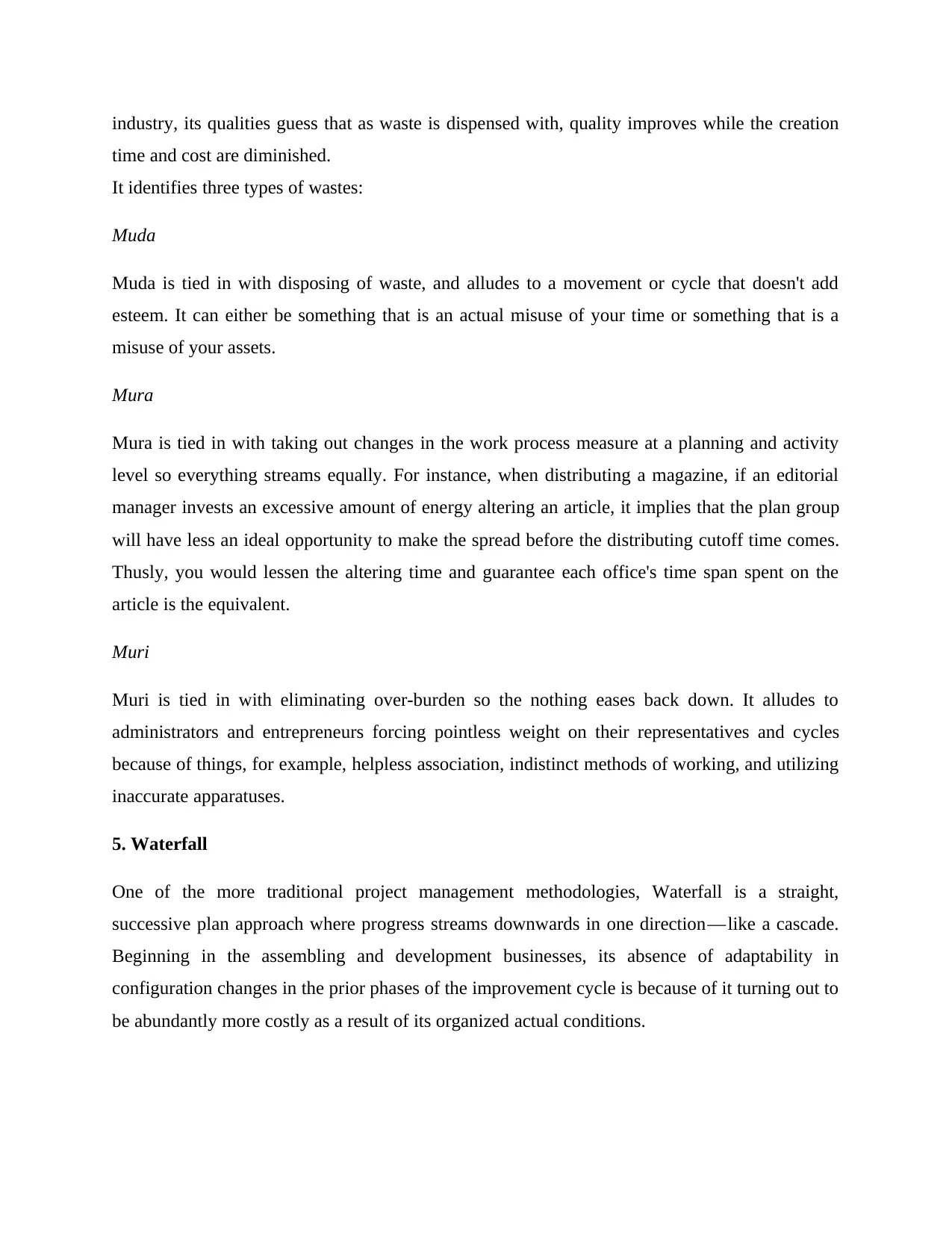
industry, its qualities guess that as waste is dispensed with, quality improves while the creation
time and cost are diminished.
It identifies three types of wastes:
Muda
Muda is tied in with disposing of waste, and alludes to a movement or cycle that doesn't add
esteem. It can either be something that is an actual misuse of your time or something that is a
misuse of your assets.
Mura
Mura is tied in with taking out changes in the work process measure at a planning and activity
level so everything streams equally. For instance, when distributing a magazine, if an editorial
manager invests an excessive amount of energy altering an article, it implies that the plan group
will have less an ideal opportunity to make the spread before the distributing cutoff time comes.
Thusly, you would lessen the altering time and guarantee each office's time span spent on the
article is the equivalent.
Muri
Muri is tied in with eliminating over-burden so the nothing eases back down. It alludes to
administrators and entrepreneurs forcing pointless weight on their representatives and cycles
because of things, for example, helpless association, indistinct methods of working, and utilizing
inaccurate apparatuses.
5. Waterfall
One of the more traditional project management methodologies, Waterfall is a straight,
successive plan approach where progress streams downwards in one direction — like a cascade.
Beginning in the assembling and development businesses, its absence of adaptability in
configuration changes in the prior phases of the improvement cycle is because of it turning out to
be abundantly more costly as a result of its organized actual conditions.
time and cost are diminished.
It identifies three types of wastes:
Muda
Muda is tied in with disposing of waste, and alludes to a movement or cycle that doesn't add
esteem. It can either be something that is an actual misuse of your time or something that is a
misuse of your assets.
Mura
Mura is tied in with taking out changes in the work process measure at a planning and activity
level so everything streams equally. For instance, when distributing a magazine, if an editorial
manager invests an excessive amount of energy altering an article, it implies that the plan group
will have less an ideal opportunity to make the spread before the distributing cutoff time comes.
Thusly, you would lessen the altering time and guarantee each office's time span spent on the
article is the equivalent.
Muri
Muri is tied in with eliminating over-burden so the nothing eases back down. It alludes to
administrators and entrepreneurs forcing pointless weight on their representatives and cycles
because of things, for example, helpless association, indistinct methods of working, and utilizing
inaccurate apparatuses.
5. Waterfall
One of the more traditional project management methodologies, Waterfall is a straight,
successive plan approach where progress streams downwards in one direction — like a cascade.
Beginning in the assembling and development businesses, its absence of adaptability in
configuration changes in the prior phases of the improvement cycle is because of it turning out to
be abundantly more costly as a result of its organized actual conditions.
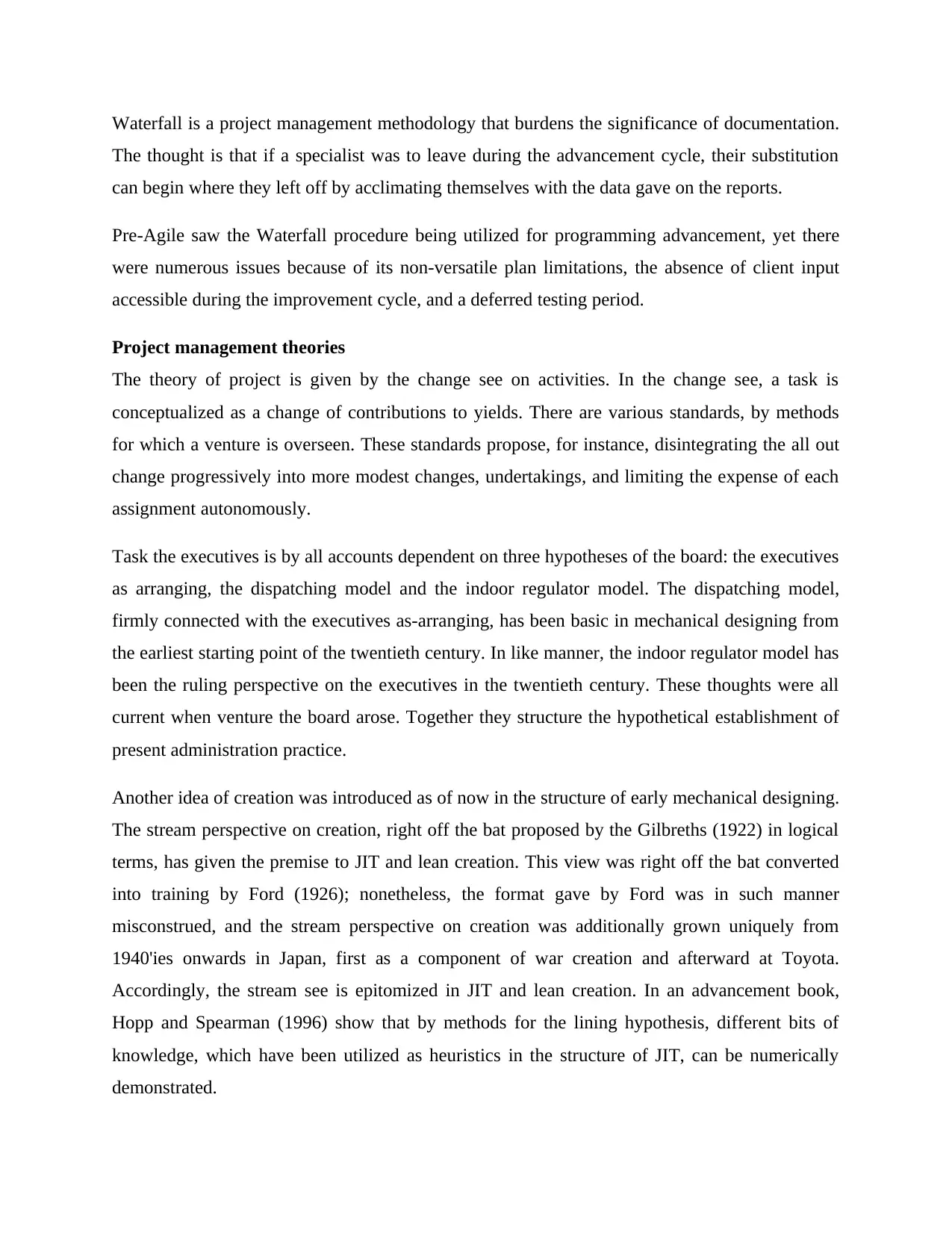
Waterfall is a project management methodology that burdens the significance of documentation.
The thought is that if a specialist was to leave during the advancement cycle, their substitution
can begin where they left off by acclimating themselves with the data gave on the reports.
Pre-Agile saw the Waterfall procedure being utilized for programming advancement, yet there
were numerous issues because of its non-versatile plan limitations, the absence of client input
accessible during the improvement cycle, and a deferred testing period.
Project management theories
The theory of project is given by the change see on activities. In the change see, a task is
conceptualized as a change of contributions to yields. There are various standards, by methods
for which a venture is overseen. These standards propose, for instance, disintegrating the all out
change progressively into more modest changes, undertakings, and limiting the expense of each
assignment autonomously.
Task the executives is by all accounts dependent on three hypotheses of the board: the executives
as arranging, the dispatching model and the indoor regulator model. The dispatching model,
firmly connected with the executives as-arranging, has been basic in mechanical designing from
the earliest starting point of the twentieth century. In like manner, the indoor regulator model has
been the ruling perspective on the executives in the twentieth century. These thoughts were all
current when venture the board arose. Together they structure the hypothetical establishment of
present administration practice.
Another idea of creation was introduced as of now in the structure of early mechanical designing.
The stream perspective on creation, right off the bat proposed by the Gilbreths (1922) in logical
terms, has given the premise to JIT and lean creation. This view was right off the bat converted
into training by Ford (1926); nonetheless, the format gave by Ford was in such manner
misconstrued, and the stream perspective on creation was additionally grown uniquely from
1940'ies onwards in Japan, first as a component of war creation and afterward at Toyota.
Accordingly, the stream see is epitomized in JIT and lean creation. In an advancement book,
Hopp and Spearman (1996) show that by methods for the lining hypothesis, different bits of
knowledge, which have been utilized as heuristics in the structure of JIT, can be numerically
demonstrated.
The thought is that if a specialist was to leave during the advancement cycle, their substitution
can begin where they left off by acclimating themselves with the data gave on the reports.
Pre-Agile saw the Waterfall procedure being utilized for programming advancement, yet there
were numerous issues because of its non-versatile plan limitations, the absence of client input
accessible during the improvement cycle, and a deferred testing period.
Project management theories
The theory of project is given by the change see on activities. In the change see, a task is
conceptualized as a change of contributions to yields. There are various standards, by methods
for which a venture is overseen. These standards propose, for instance, disintegrating the all out
change progressively into more modest changes, undertakings, and limiting the expense of each
assignment autonomously.
Task the executives is by all accounts dependent on three hypotheses of the board: the executives
as arranging, the dispatching model and the indoor regulator model. The dispatching model,
firmly connected with the executives as-arranging, has been basic in mechanical designing from
the earliest starting point of the twentieth century. In like manner, the indoor regulator model has
been the ruling perspective on the executives in the twentieth century. These thoughts were all
current when venture the board arose. Together they structure the hypothetical establishment of
present administration practice.
Another idea of creation was introduced as of now in the structure of early mechanical designing.
The stream perspective on creation, right off the bat proposed by the Gilbreths (1922) in logical
terms, has given the premise to JIT and lean creation. This view was right off the bat converted
into training by Ford (1926); nonetheless, the format gave by Ford was in such manner
misconstrued, and the stream perspective on creation was additionally grown uniquely from
1940'ies onwards in Japan, first as a component of war creation and afterward at Toyota.
Accordingly, the stream see is epitomized in JIT and lean creation. In an advancement book,
Hopp and Spearman (1996) show that by methods for the lining hypothesis, different bits of
knowledge, which have been utilized as heuristics in the structure of JIT, can be numerically
demonstrated.
⊘ This is a preview!⊘
Do you want full access?
Subscribe today to unlock all pages.

Trusted by 1+ million students worldwide
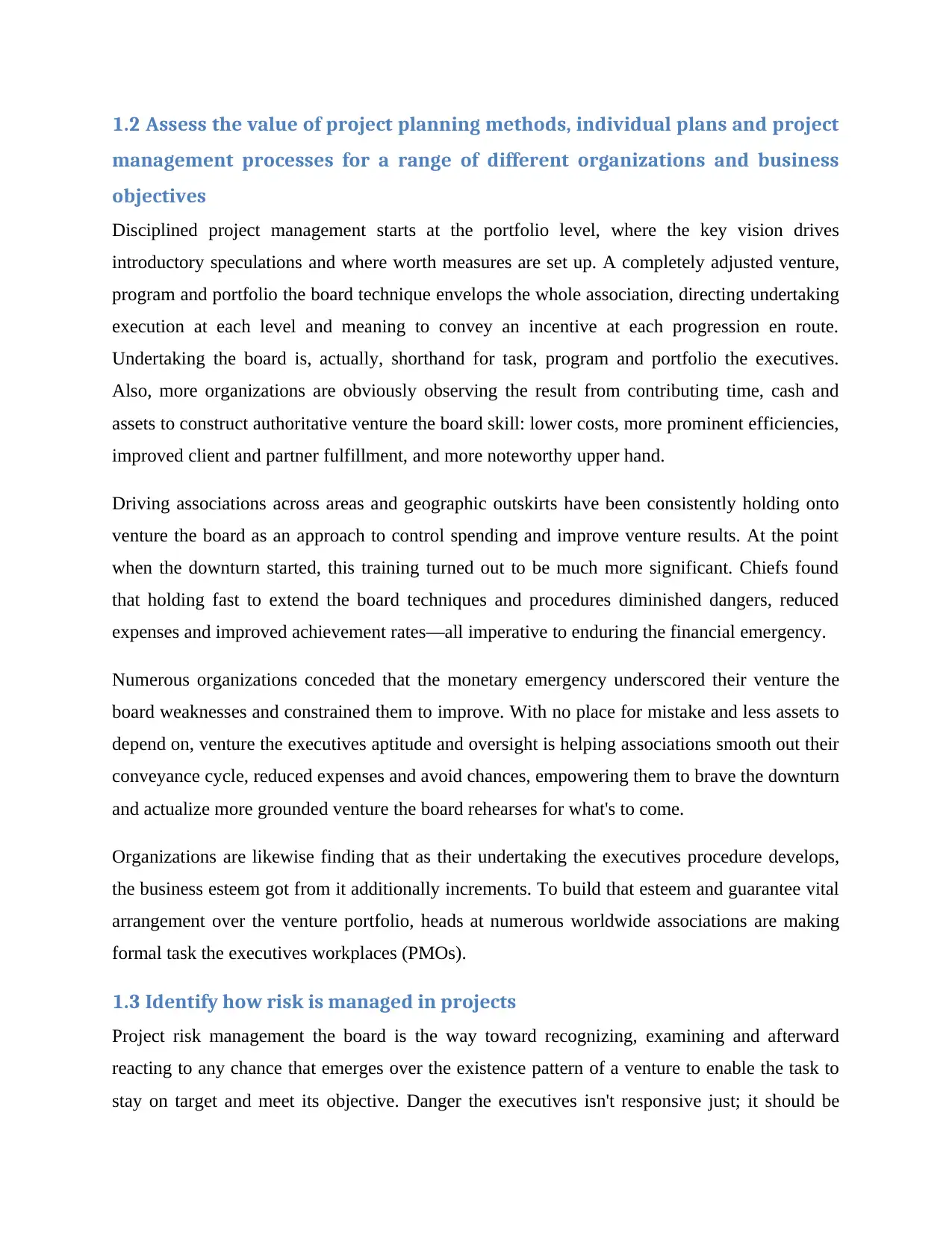
1.2 Assess the value of project planning methods, individual plans and project
management processes for a range of different organizations and business
objectives
Disciplined project management starts at the portfolio level, where the key vision drives
introductory speculations and where worth measures are set up. A completely adjusted venture,
program and portfolio the board technique envelops the whole association, directing undertaking
execution at each level and meaning to convey an incentive at each progression en route.
Undertaking the board is, actually, shorthand for task, program and portfolio the executives.
Also, more organizations are obviously observing the result from contributing time, cash and
assets to construct authoritative venture the board skill: lower costs, more prominent efficiencies,
improved client and partner fulfillment, and more noteworthy upper hand.
Driving associations across areas and geographic outskirts have been consistently holding onto
venture the board as an approach to control spending and improve venture results. At the point
when the downturn started, this training turned out to be much more significant. Chiefs found
that holding fast to extend the board techniques and procedures diminished dangers, reduced
expenses and improved achievement rates—all imperative to enduring the financial emergency.
Numerous organizations conceded that the monetary emergency underscored their venture the
board weaknesses and constrained them to improve. With no place for mistake and less assets to
depend on, venture the executives aptitude and oversight is helping associations smooth out their
conveyance cycle, reduced expenses and avoid chances, empowering them to brave the downturn
and actualize more grounded venture the board rehearses for what's to come.
Organizations are likewise finding that as their undertaking the executives procedure develops,
the business esteem got from it additionally increments. To build that esteem and guarantee vital
arrangement over the venture portfolio, heads at numerous worldwide associations are making
formal task the executives workplaces (PMOs).
1.3 Identify how risk is managed in projects
Project risk management the board is the way toward recognizing, examining and afterward
reacting to any chance that emerges over the existence pattern of a venture to enable the task to
stay on target and meet its objective. Danger the executives isn't responsive just; it should be
management processes for a range of different organizations and business
objectives
Disciplined project management starts at the portfolio level, where the key vision drives
introductory speculations and where worth measures are set up. A completely adjusted venture,
program and portfolio the board technique envelops the whole association, directing undertaking
execution at each level and meaning to convey an incentive at each progression en route.
Undertaking the board is, actually, shorthand for task, program and portfolio the executives.
Also, more organizations are obviously observing the result from contributing time, cash and
assets to construct authoritative venture the board skill: lower costs, more prominent efficiencies,
improved client and partner fulfillment, and more noteworthy upper hand.
Driving associations across areas and geographic outskirts have been consistently holding onto
venture the board as an approach to control spending and improve venture results. At the point
when the downturn started, this training turned out to be much more significant. Chiefs found
that holding fast to extend the board techniques and procedures diminished dangers, reduced
expenses and improved achievement rates—all imperative to enduring the financial emergency.
Numerous organizations conceded that the monetary emergency underscored their venture the
board weaknesses and constrained them to improve. With no place for mistake and less assets to
depend on, venture the executives aptitude and oversight is helping associations smooth out their
conveyance cycle, reduced expenses and avoid chances, empowering them to brave the downturn
and actualize more grounded venture the board rehearses for what's to come.
Organizations are likewise finding that as their undertaking the executives procedure develops,
the business esteem got from it additionally increments. To build that esteem and guarantee vital
arrangement over the venture portfolio, heads at numerous worldwide associations are making
formal task the executives workplaces (PMOs).
1.3 Identify how risk is managed in projects
Project risk management the board is the way toward recognizing, examining and afterward
reacting to any chance that emerges over the existence pattern of a venture to enable the task to
stay on target and meet its objective. Danger the executives isn't responsive just; it should be
Paraphrase This Document
Need a fresh take? Get an instant paraphrase of this document with our AI Paraphraser
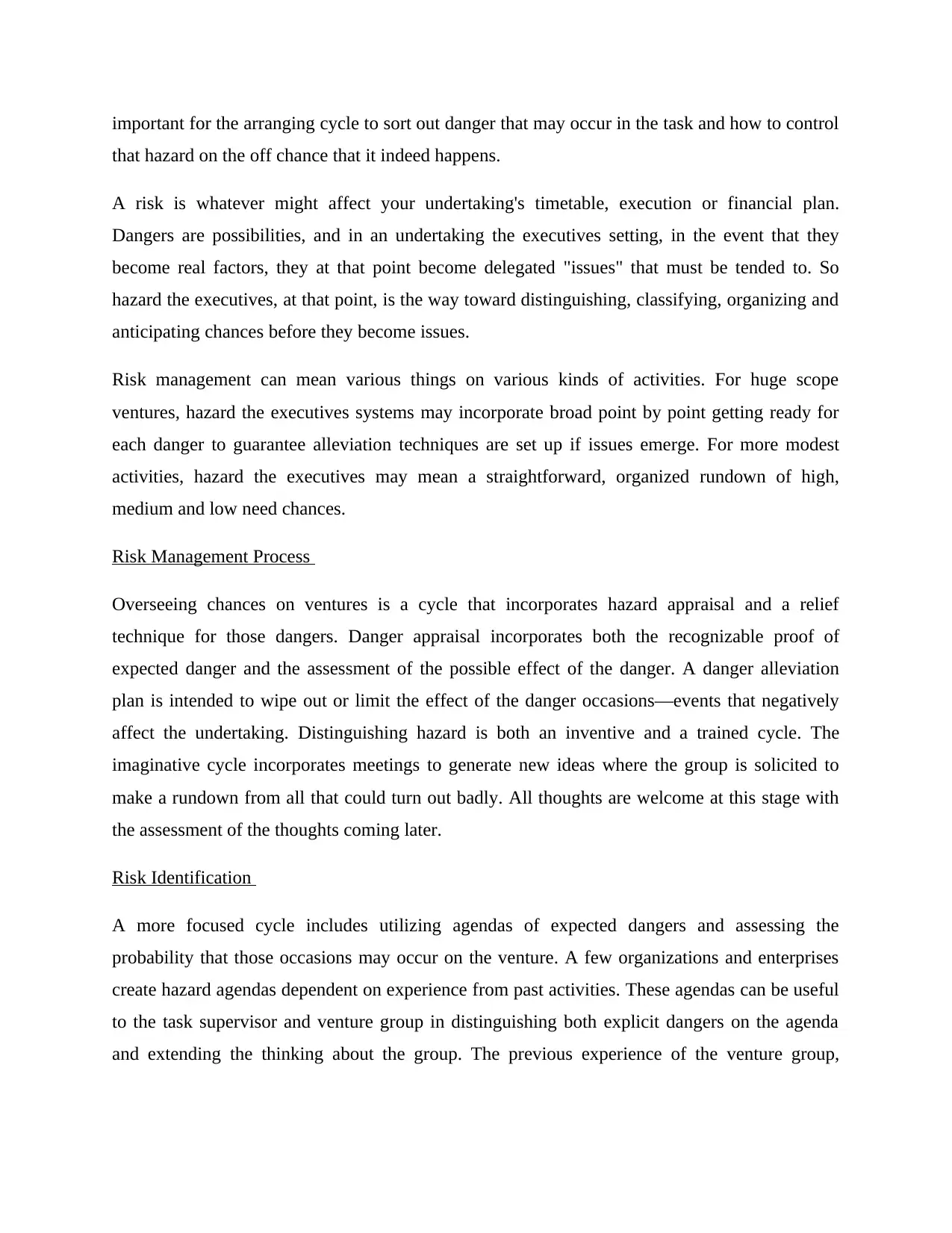
important for the arranging cycle to sort out danger that may occur in the task and how to control
that hazard on the off chance that it indeed happens.
A risk is whatever might affect your undertaking's timetable, execution or financial plan.
Dangers are possibilities, and in an undertaking the executives setting, in the event that they
become real factors, they at that point become delegated "issues" that must be tended to. So
hazard the executives, at that point, is the way toward distinguishing, classifying, organizing and
anticipating chances before they become issues.
Risk management can mean various things on various kinds of activities. For huge scope
ventures, hazard the executives systems may incorporate broad point by point getting ready for
each danger to guarantee alleviation techniques are set up if issues emerge. For more modest
activities, hazard the executives may mean a straightforward, organized rundown of high,
medium and low need chances.
Risk Management Process
Overseeing chances on ventures is a cycle that incorporates hazard appraisal and a relief
technique for those dangers. Danger appraisal incorporates both the recognizable proof of
expected danger and the assessment of the possible effect of the danger. A danger alleviation
plan is intended to wipe out or limit the effect of the danger occasions—events that negatively
affect the undertaking. Distinguishing hazard is both an inventive and a trained cycle. The
imaginative cycle incorporates meetings to generate new ideas where the group is solicited to
make a rundown from all that could turn out badly. All thoughts are welcome at this stage with
the assessment of the thoughts coming later.
Risk Identification
A more focused cycle includes utilizing agendas of expected dangers and assessing the
probability that those occasions may occur on the venture. A few organizations and enterprises
create hazard agendas dependent on experience from past activities. These agendas can be useful
to the task supervisor and venture group in distinguishing both explicit dangers on the agenda
and extending the thinking about the group. The previous experience of the venture group,
that hazard on the off chance that it indeed happens.
A risk is whatever might affect your undertaking's timetable, execution or financial plan.
Dangers are possibilities, and in an undertaking the executives setting, in the event that they
become real factors, they at that point become delegated "issues" that must be tended to. So
hazard the executives, at that point, is the way toward distinguishing, classifying, organizing and
anticipating chances before they become issues.
Risk management can mean various things on various kinds of activities. For huge scope
ventures, hazard the executives systems may incorporate broad point by point getting ready for
each danger to guarantee alleviation techniques are set up if issues emerge. For more modest
activities, hazard the executives may mean a straightforward, organized rundown of high,
medium and low need chances.
Risk Management Process
Overseeing chances on ventures is a cycle that incorporates hazard appraisal and a relief
technique for those dangers. Danger appraisal incorporates both the recognizable proof of
expected danger and the assessment of the possible effect of the danger. A danger alleviation
plan is intended to wipe out or limit the effect of the danger occasions—events that negatively
affect the undertaking. Distinguishing hazard is both an inventive and a trained cycle. The
imaginative cycle incorporates meetings to generate new ideas where the group is solicited to
make a rundown from all that could turn out badly. All thoughts are welcome at this stage with
the assessment of the thoughts coming later.
Risk Identification
A more focused cycle includes utilizing agendas of expected dangers and assessing the
probability that those occasions may occur on the venture. A few organizations and enterprises
create hazard agendas dependent on experience from past activities. These agendas can be useful
to the task supervisor and venture group in distinguishing both explicit dangers on the agenda
and extending the thinking about the group. The previous experience of the venture group,
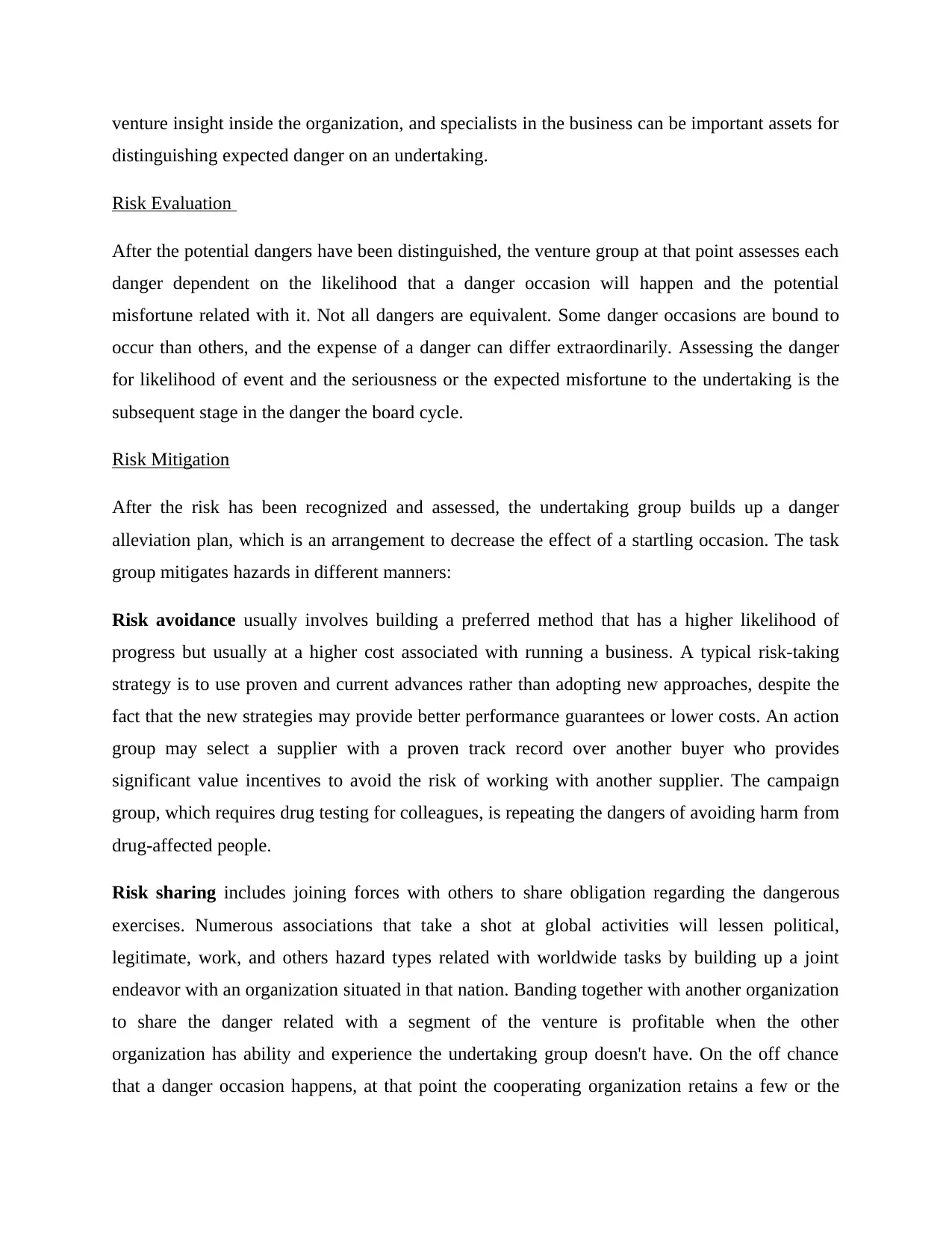
venture insight inside the organization, and specialists in the business can be important assets for
distinguishing expected danger on an undertaking.
Risk Evaluation
After the potential dangers have been distinguished, the venture group at that point assesses each
danger dependent on the likelihood that a danger occasion will happen and the potential
misfortune related with it. Not all dangers are equivalent. Some danger occasions are bound to
occur than others, and the expense of a danger can differ extraordinarily. Assessing the danger
for likelihood of event and the seriousness or the expected misfortune to the undertaking is the
subsequent stage in the danger the board cycle.
Risk Mitigation
After the risk has been recognized and assessed, the undertaking group builds up a danger
alleviation plan, which is an arrangement to decrease the effect of a startling occasion. The task
group mitigates hazards in different manners:
Risk avoidance usually involves building a preferred method that has a higher likelihood of
progress but usually at a higher cost associated with running a business. A typical risk-taking
strategy is to use proven and current advances rather than adopting new approaches, despite the
fact that the new strategies may provide better performance guarantees or lower costs. An action
group may select a supplier with a proven track record over another buyer who provides
significant value incentives to avoid the risk of working with another supplier. The campaign
group, which requires drug testing for colleagues, is repeating the dangers of avoiding harm from
drug-affected people.
Risk sharing includes joining forces with others to share obligation regarding the dangerous
exercises. Numerous associations that take a shot at global activities will lessen political,
legitimate, work, and others hazard types related with worldwide tasks by building up a joint
endeavor with an organization situated in that nation. Banding together with another organization
to share the danger related with a segment of the venture is profitable when the other
organization has ability and experience the undertaking group doesn't have. On the off chance
that a danger occasion happens, at that point the cooperating organization retains a few or the
distinguishing expected danger on an undertaking.
Risk Evaluation
After the potential dangers have been distinguished, the venture group at that point assesses each
danger dependent on the likelihood that a danger occasion will happen and the potential
misfortune related with it. Not all dangers are equivalent. Some danger occasions are bound to
occur than others, and the expense of a danger can differ extraordinarily. Assessing the danger
for likelihood of event and the seriousness or the expected misfortune to the undertaking is the
subsequent stage in the danger the board cycle.
Risk Mitigation
After the risk has been recognized and assessed, the undertaking group builds up a danger
alleviation plan, which is an arrangement to decrease the effect of a startling occasion. The task
group mitigates hazards in different manners:
Risk avoidance usually involves building a preferred method that has a higher likelihood of
progress but usually at a higher cost associated with running a business. A typical risk-taking
strategy is to use proven and current advances rather than adopting new approaches, despite the
fact that the new strategies may provide better performance guarantees or lower costs. An action
group may select a supplier with a proven track record over another buyer who provides
significant value incentives to avoid the risk of working with another supplier. The campaign
group, which requires drug testing for colleagues, is repeating the dangers of avoiding harm from
drug-affected people.
Risk sharing includes joining forces with others to share obligation regarding the dangerous
exercises. Numerous associations that take a shot at global activities will lessen political,
legitimate, work, and others hazard types related with worldwide tasks by building up a joint
endeavor with an organization situated in that nation. Banding together with another organization
to share the danger related with a segment of the venture is profitable when the other
organization has ability and experience the undertaking group doesn't have. On the off chance
that a danger occasion happens, at that point the cooperating organization retains a few or the
⊘ This is a preview!⊘
Do you want full access?
Subscribe today to unlock all pages.

Trusted by 1+ million students worldwide
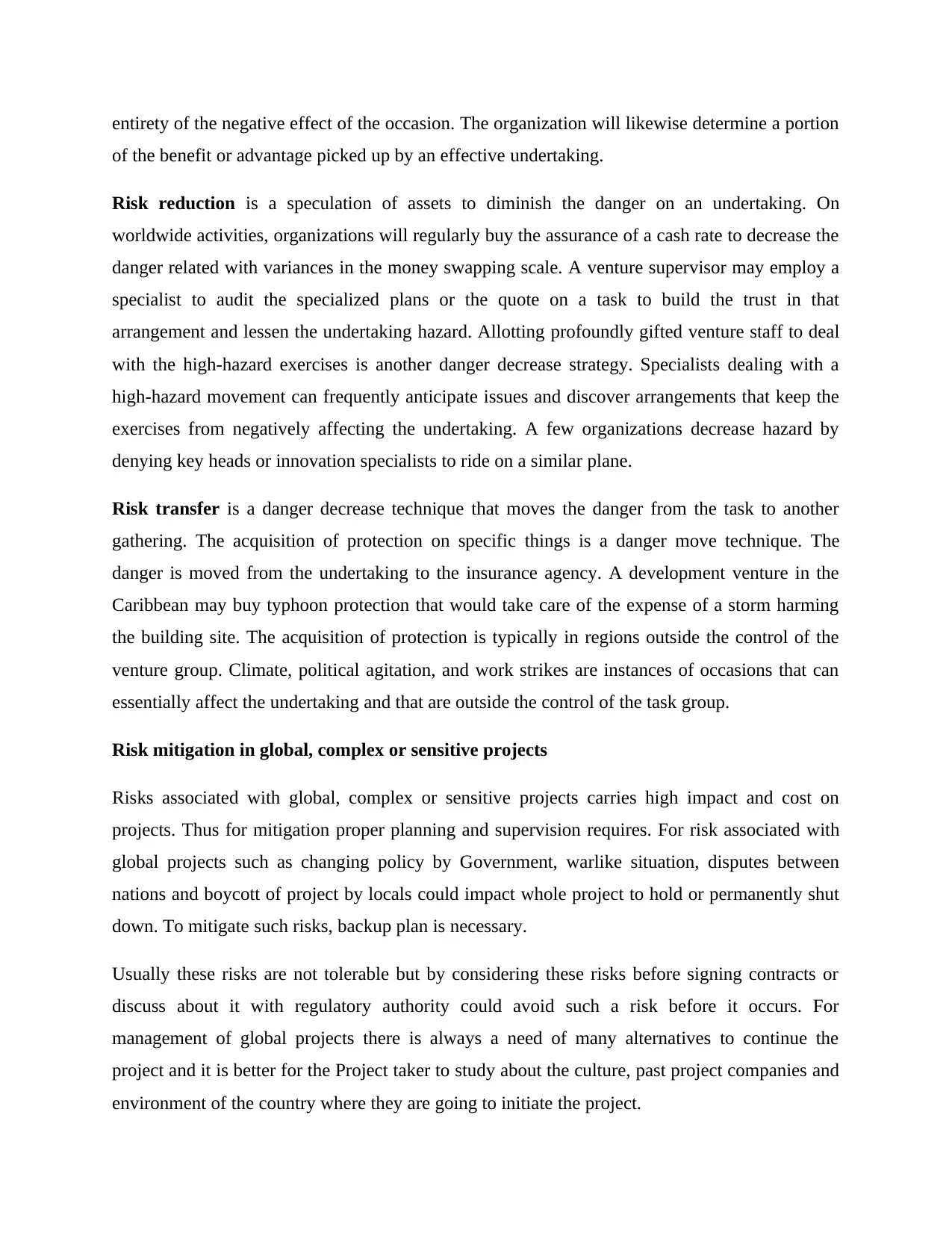
entirety of the negative effect of the occasion. The organization will likewise determine a portion
of the benefit or advantage picked up by an effective undertaking.
Risk reduction is a speculation of assets to diminish the danger on an undertaking. On
worldwide activities, organizations will regularly buy the assurance of a cash rate to decrease the
danger related with variances in the money swapping scale. A venture supervisor may employ a
specialist to audit the specialized plans or the quote on a task to build the trust in that
arrangement and lessen the undertaking hazard. Allotting profoundly gifted venture staff to deal
with the high-hazard exercises is another danger decrease strategy. Specialists dealing with a
high-hazard movement can frequently anticipate issues and discover arrangements that keep the
exercises from negatively affecting the undertaking. A few organizations decrease hazard by
denying key heads or innovation specialists to ride on a similar plane.
Risk transfer is a danger decrease technique that moves the danger from the task to another
gathering. The acquisition of protection on specific things is a danger move technique. The
danger is moved from the undertaking to the insurance agency. A development venture in the
Caribbean may buy typhoon protection that would take care of the expense of a storm harming
the building site. The acquisition of protection is typically in regions outside the control of the
venture group. Climate, political agitation, and work strikes are instances of occasions that can
essentially affect the undertaking and that are outside the control of the task group.
Risk mitigation in global, complex or sensitive projects
Risks associated with global, complex or sensitive projects carries high impact and cost on
projects. Thus for mitigation proper planning and supervision requires. For risk associated with
global projects such as changing policy by Government, warlike situation, disputes between
nations and boycott of project by locals could impact whole project to hold or permanently shut
down. To mitigate such risks, backup plan is necessary.
Usually these risks are not tolerable but by considering these risks before signing contracts or
discuss about it with regulatory authority could avoid such a risk before it occurs. For
management of global projects there is always a need of many alternatives to continue the
project and it is better for the Project taker to study about the culture, past project companies and
environment of the country where they are going to initiate the project.
of the benefit or advantage picked up by an effective undertaking.
Risk reduction is a speculation of assets to diminish the danger on an undertaking. On
worldwide activities, organizations will regularly buy the assurance of a cash rate to decrease the
danger related with variances in the money swapping scale. A venture supervisor may employ a
specialist to audit the specialized plans or the quote on a task to build the trust in that
arrangement and lessen the undertaking hazard. Allotting profoundly gifted venture staff to deal
with the high-hazard exercises is another danger decrease strategy. Specialists dealing with a
high-hazard movement can frequently anticipate issues and discover arrangements that keep the
exercises from negatively affecting the undertaking. A few organizations decrease hazard by
denying key heads or innovation specialists to ride on a similar plane.
Risk transfer is a danger decrease technique that moves the danger from the task to another
gathering. The acquisition of protection on specific things is a danger move technique. The
danger is moved from the undertaking to the insurance agency. A development venture in the
Caribbean may buy typhoon protection that would take care of the expense of a storm harming
the building site. The acquisition of protection is typically in regions outside the control of the
venture group. Climate, political agitation, and work strikes are instances of occasions that can
essentially affect the undertaking and that are outside the control of the task group.
Risk mitigation in global, complex or sensitive projects
Risks associated with global, complex or sensitive projects carries high impact and cost on
projects. Thus for mitigation proper planning and supervision requires. For risk associated with
global projects such as changing policy by Government, warlike situation, disputes between
nations and boycott of project by locals could impact whole project to hold or permanently shut
down. To mitigate such risks, backup plan is necessary.
Usually these risks are not tolerable but by considering these risks before signing contracts or
discuss about it with regulatory authority could avoid such a risk before it occurs. For
management of global projects there is always a need of many alternatives to continue the
project and it is better for the Project taker to study about the culture, past project companies and
environment of the country where they are going to initiate the project.
Paraphrase This Document
Need a fresh take? Get an instant paraphrase of this document with our AI Paraphraser
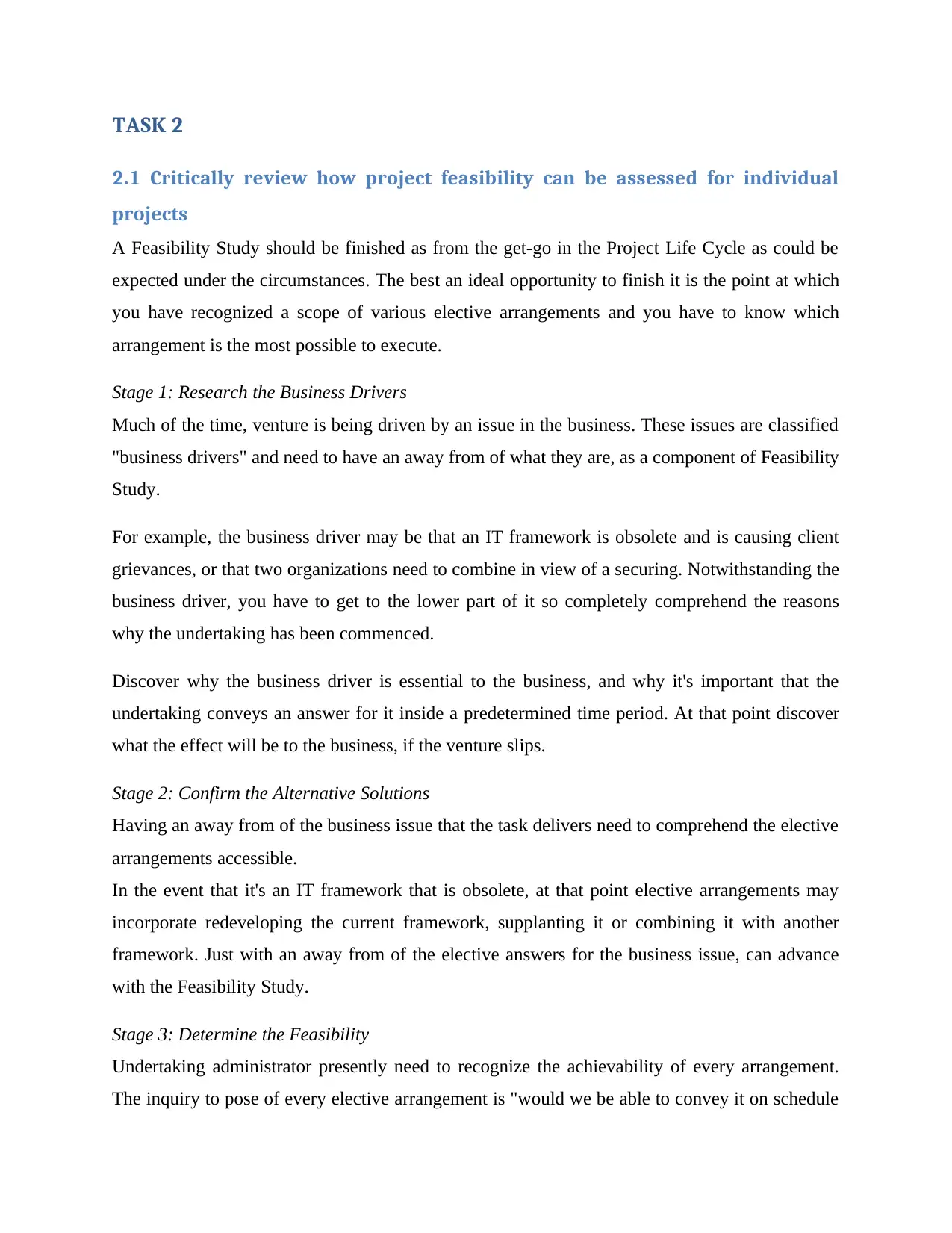
TASK 2
2.1 Critically review how project feasibility can be assessed for individual
projects
A Feasibility Study should be finished as from the get-go in the Project Life Cycle as could be
expected under the circumstances. The best an ideal opportunity to finish it is the point at which
you have recognized a scope of various elective arrangements and you have to know which
arrangement is the most possible to execute.
Stage 1: Research the Business Drivers
Much of the time, venture is being driven by an issue in the business. These issues are classified
"business drivers" and need to have an away from of what they are, as a component of Feasibility
Study.
For example, the business driver may be that an IT framework is obsolete and is causing client
grievances, or that two organizations need to combine in view of a securing. Notwithstanding the
business driver, you have to get to the lower part of it so completely comprehend the reasons
why the undertaking has been commenced.
Discover why the business driver is essential to the business, and why it's important that the
undertaking conveys an answer for it inside a predetermined time period. At that point discover
what the effect will be to the business, if the venture slips.
Stage 2: Confirm the Alternative Solutions
Having an away from of the business issue that the task delivers need to comprehend the elective
arrangements accessible.
In the event that it's an IT framework that is obsolete, at that point elective arrangements may
incorporate redeveloping the current framework, supplanting it or combining it with another
framework. Just with an away from of the elective answers for the business issue, can advance
with the Feasibility Study.
Stage 3: Determine the Feasibility
Undertaking administrator presently need to recognize the achievability of every arrangement.
The inquiry to pose of every elective arrangement is "would we be able to convey it on schedule
2.1 Critically review how project feasibility can be assessed for individual
projects
A Feasibility Study should be finished as from the get-go in the Project Life Cycle as could be
expected under the circumstances. The best an ideal opportunity to finish it is the point at which
you have recognized a scope of various elective arrangements and you have to know which
arrangement is the most possible to execute.
Stage 1: Research the Business Drivers
Much of the time, venture is being driven by an issue in the business. These issues are classified
"business drivers" and need to have an away from of what they are, as a component of Feasibility
Study.
For example, the business driver may be that an IT framework is obsolete and is causing client
grievances, or that two organizations need to combine in view of a securing. Notwithstanding the
business driver, you have to get to the lower part of it so completely comprehend the reasons
why the undertaking has been commenced.
Discover why the business driver is essential to the business, and why it's important that the
undertaking conveys an answer for it inside a predetermined time period. At that point discover
what the effect will be to the business, if the venture slips.
Stage 2: Confirm the Alternative Solutions
Having an away from of the business issue that the task delivers need to comprehend the elective
arrangements accessible.
In the event that it's an IT framework that is obsolete, at that point elective arrangements may
incorporate redeveloping the current framework, supplanting it or combining it with another
framework. Just with an away from of the elective answers for the business issue, can advance
with the Feasibility Study.
Stage 3: Determine the Feasibility
Undertaking administrator presently need to recognize the achievability of every arrangement.
The inquiry to pose of every elective arrangement is "would we be able to convey it on schedule
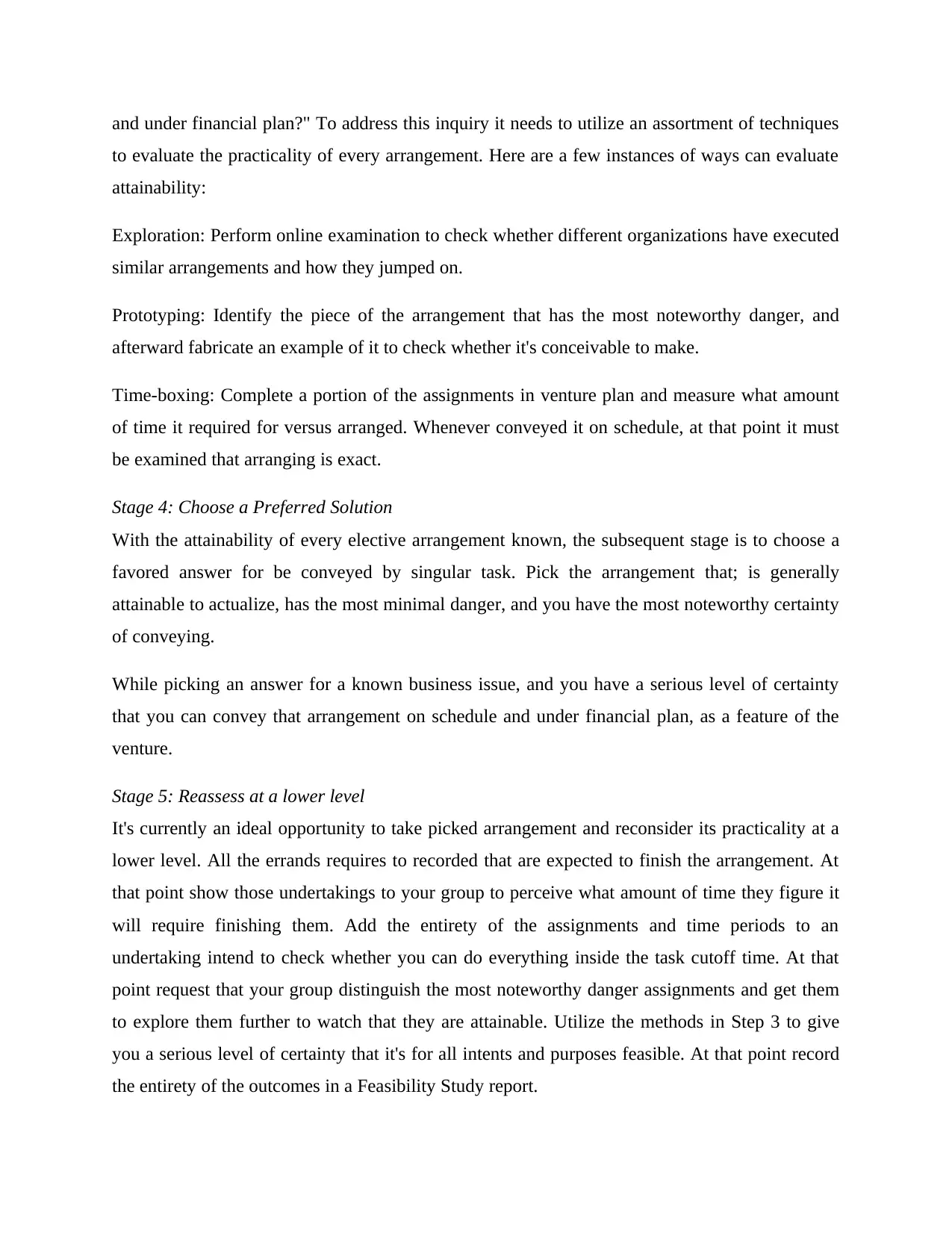
and under financial plan?" To address this inquiry it needs to utilize an assortment of techniques
to evaluate the practicality of every arrangement. Here are a few instances of ways can evaluate
attainability:
Exploration: Perform online examination to check whether different organizations have executed
similar arrangements and how they jumped on.
Prototyping: Identify the piece of the arrangement that has the most noteworthy danger, and
afterward fabricate an example of it to check whether it's conceivable to make.
Time-boxing: Complete a portion of the assignments in venture plan and measure what amount
of time it required for versus arranged. Whenever conveyed it on schedule, at that point it must
be examined that arranging is exact.
Stage 4: Choose a Preferred Solution
With the attainability of every elective arrangement known, the subsequent stage is to choose a
favored answer for be conveyed by singular task. Pick the arrangement that; is generally
attainable to actualize, has the most minimal danger, and you have the most noteworthy certainty
of conveying.
While picking an answer for a known business issue, and you have a serious level of certainty
that you can convey that arrangement on schedule and under financial plan, as a feature of the
venture.
Stage 5: Reassess at a lower level
It's currently an ideal opportunity to take picked arrangement and reconsider its practicality at a
lower level. All the errands requires to recorded that are expected to finish the arrangement. At
that point show those undertakings to your group to perceive what amount of time they figure it
will require finishing them. Add the entirety of the assignments and time periods to an
undertaking intend to check whether you can do everything inside the task cutoff time. At that
point request that your group distinguish the most noteworthy danger assignments and get them
to explore them further to watch that they are attainable. Utilize the methods in Step 3 to give
you a serious level of certainty that it's for all intents and purposes feasible. At that point record
the entirety of the outcomes in a Feasibility Study report.
to evaluate the practicality of every arrangement. Here are a few instances of ways can evaluate
attainability:
Exploration: Perform online examination to check whether different organizations have executed
similar arrangements and how they jumped on.
Prototyping: Identify the piece of the arrangement that has the most noteworthy danger, and
afterward fabricate an example of it to check whether it's conceivable to make.
Time-boxing: Complete a portion of the assignments in venture plan and measure what amount
of time it required for versus arranged. Whenever conveyed it on schedule, at that point it must
be examined that arranging is exact.
Stage 4: Choose a Preferred Solution
With the attainability of every elective arrangement known, the subsequent stage is to choose a
favored answer for be conveyed by singular task. Pick the arrangement that; is generally
attainable to actualize, has the most minimal danger, and you have the most noteworthy certainty
of conveying.
While picking an answer for a known business issue, and you have a serious level of certainty
that you can convey that arrangement on schedule and under financial plan, as a feature of the
venture.
Stage 5: Reassess at a lower level
It's currently an ideal opportunity to take picked arrangement and reconsider its practicality at a
lower level. All the errands requires to recorded that are expected to finish the arrangement. At
that point show those undertakings to your group to perceive what amount of time they figure it
will require finishing them. Add the entirety of the assignments and time periods to an
undertaking intend to check whether you can do everything inside the task cutoff time. At that
point request that your group distinguish the most noteworthy danger assignments and get them
to explore them further to watch that they are attainable. Utilize the methods in Step 3 to give
you a serious level of certainty that it's for all intents and purposes feasible. At that point record
the entirety of the outcomes in a Feasibility Study report.
⊘ This is a preview!⊘
Do you want full access?
Subscribe today to unlock all pages.

Trusted by 1+ million students worldwide
1 out of 16
Related Documents
Your All-in-One AI-Powered Toolkit for Academic Success.
+13062052269
info@desklib.com
Available 24*7 on WhatsApp / Email
![[object Object]](/_next/static/media/star-bottom.7253800d.svg)
Unlock your academic potential
Copyright © 2020–2025 A2Z Services. All Rights Reserved. Developed and managed by ZUCOL.





